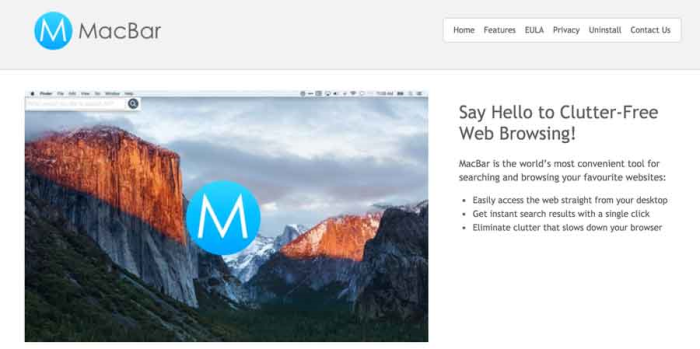What is MacBar?
According to the official website, MacBar application is a handy tool for improving Internet search process and browsing experience, in a whole. Though the information sounds promising, after using MacBar for a while, it becomes clear that the program is an adware. After its installation you may see pop-ups and banners with offers from online stores, however we wouldn’t recommend believing in it. As many other adware applications, MacBar also implies to spyware techniques and tracks your browsing history. Afterwards this information is used to generate fake, but so attractive and relevant to your interests, ads. Since the commercials are totally phony, they have no connection to shopping sources, and will redirect you to third-party sites instead. To get rid of these redirections and to clear your browser from ads you need to remove MacBar adware.

How MacBar got installed on your computer?
The majority of malware applications, like MacBar, infect systems being installed together with freeware or shareware. And this method works fine, since many computer users tend to be inattentive when they install new programs, and even worse, the majority of users don’t pay attention to details of installations. However, only by doing so you can prevent malware from getting into your system. When getting through an installation process, read thoroughly the information on the screens, and if you see additional elements, it would be safe to cancel the installation.
Symptoms of MacBar infection
- First and the most striking proof of what you have an adware is ads generated on pages where they haven’t appeared before. The ads can be of any type – pop-ups, in-text hyperlinks, banners and their amount increases on shopping sites. Some of them may be labeled as “Ads by MacBar”, “Brought by MacBar”, “Powered by MacBar”, etc.
- Another indicator of adware infection is appearance of new programs that you don’t remember installing and processes in start-up queue.
- Also, you may notice the significant slowdown in the system operating, since running of the applications required for adware activity may consume a lot of CPU.
- Besides slowing down the computer itself, adware infection may as well negatively affect the speed of Internet connection.
How to remove MacBar?
Performing an antimalware scan with Norton Antivirus would automatically search out and delete all elements related to MacBar. It is not only the easiest way to eliminate MacBar, but also the safest and most assuring one.
Steps of MacBar manual removal
Uninstall MacBar from the system
As it was stated before, more likely that the adware appeared on your system brought by other software. So, to get rid of MacBar you need to call to memory what you have installed recently.
How to remove MacBar from Mac
- Open a Finder window
- Click Applications line on the sidebar
- Select the application related to MacBar right-click it and choose Move to Trash
Remove MacBar from browsers
Since most of adware threats use a disguise of a browser add-on, you will need to check the list of extensions/add-ons in your browser.
How to remove MacBar from Safari
- Start Safari
- Click on Safari menu button, then go to the Extensions
- Delete MacBar or other extensions that look suspicious and you don’t remember installing them
How to remove MacBar from Google Chrome
- Start Google Chrome
- Click on Tools, then go to the Extensions
- Delete MacBar or other extensions that look suspicious and you don’t remember installing them
How to remove MacBar from Mozilla Firefox
- Start Mozilla Firefox
- Click on the right-upper corner button
- Click Add-ons, then go to Extensions
- Delete MacBar or other extensions that look suspicious and you don’t remember installing them
If the above-mentioned methods didn’t help in eliminating the threat, then it’s better to rely on an automatic way of deleting MacBar.
We also recommend to download and use Norton to scan the system after MacBar removal to make sure that it is completely gone. The antimalware application will detect any vicious components left among system files and registry entries that can recover MacBar.




